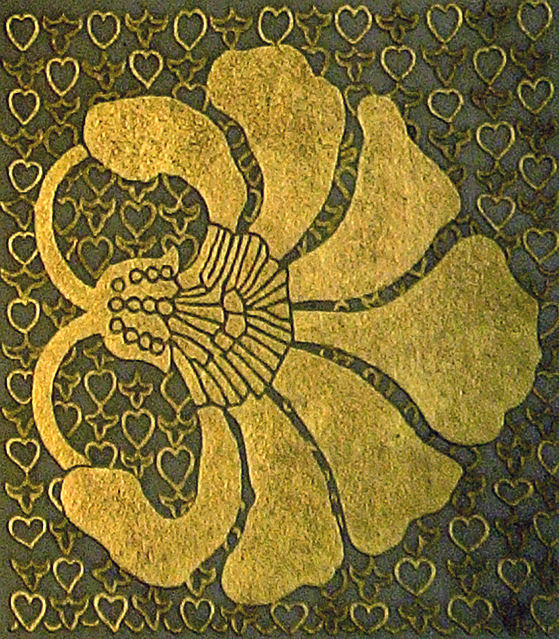
The Arts and Crafts Context of Central Congregational Church
Ariana Regalado
England gave birth to the Arts and Crafts Movement in the 1880s. The movement derived its philosophical ideals from two important British sources: John Ruskin and William Morris. As a theorist and art critic, John Ruskin advocated medieval architecture as a model for honest craftsmanship and quality materials. Ruskin’s writings, such as the Bible of Amiens were deeply influential in Whitman’s Boston Society. William Morris, an artist and founder of a design firm, believed that industrialization alienated labor and created a dehumanizing distance between the designer and manufacturer. While Ruskin aimed to produce luxurious interiors, Morris strove to unite all the arts within the decoration of the home, emphasizing nature and simplicity of form. His textiles such Windrush of 1883
were widely disseminated. In 1882 Morris’s stained glass was introduced into Trinity Church. Boston in the north transept and later the baptistery.
Although the movement did not promote a particular style, it did advocate reform as part of its philosophy and instigated a critique of industrial labor. The Arts and Crafts Movement emphasized the importance of taking into account the whole interior. It aimed to bring back the concept of hand craftsmanship in order to make people feel as if their home was an artistic entity in itself instead rather than a place where art, such as a painting, would hang on a living-room wall. Americans embraced the Arts and Crafts movement, placing importance on its spiritual and ethical aspects. The domestic nature of the movement, improving the intellectual and moral standards of the family, was directly related women’s success in many of its expressions.
 With its heritage of English culture, Boston was a hotbed for the Arts and Crafts movement starting in the early 1890s. In the spring of 1897, a small group of architects, craftspeople, educators, and collectors organized the first arts and crafts exhibition in the country. Its success led to the creation of Boston Society of Arts and Crafts, an organization devoted to the development and promotion of higher standards in the handicrafts. Ideas that encouraged women in Arts and Crafts Boston were similar to practices in England. Walter Smith, a graduate of London’s South Kensington School had been hired in 1873 as the first director of the Massachusetts Normal Art School (now Massachusetts College of Art and Design or MassArt), which attracted many students. Smith advocated women’s involvement in the arts. In 1899 in Boston’s North End a philanthropic movement established a reading group for immigrant girls later named the Saturday Evening Girls. In 1907 the group founded the Paul Revere Pottery Company later located in Brighton, which offered the girls opportunities to earn good wages creating pottery. Ida Goldstein was between 17 and 20 years old when she executed a chrysanthemum vase. Showing similar abstracted contour and elegant silhouette as Whitman’s work, the vase, made between 1911 and 1914, is reminiscent of the artist’s design for the cover of Sarah Orne Jewett’s Betty Leicester of 1890.
With its heritage of English culture, Boston was a hotbed for the Arts and Crafts movement starting in the early 1890s. In the spring of 1897, a small group of architects, craftspeople, educators, and collectors organized the first arts and crafts exhibition in the country. Its success led to the creation of Boston Society of Arts and Crafts, an organization devoted to the development and promotion of higher standards in the handicrafts. Ideas that encouraged women in Arts and Crafts Boston were similar to practices in England. Walter Smith, a graduate of London’s South Kensington School had been hired in 1873 as the first director of the Massachusetts Normal Art School (now Massachusetts College of Art and Design or MassArt), which attracted many students. Smith advocated women’s involvement in the arts. In 1899 in Boston’s North End a philanthropic movement established a reading group for immigrant girls later named the Saturday Evening Girls. In 1907 the group founded the Paul Revere Pottery Company later located in Brighton, which offered the girls opportunities to earn good wages creating pottery. Ida Goldstein was between 17 and 20 years old when she executed a chrysanthemum vase. Showing similar abstracted contour and elegant silhouette as Whitman’s work, the vase, made between 1911 and 1914, is reminiscent of the artist’s design for the cover of Sarah Orne Jewett’s Betty Leicester of 1890.
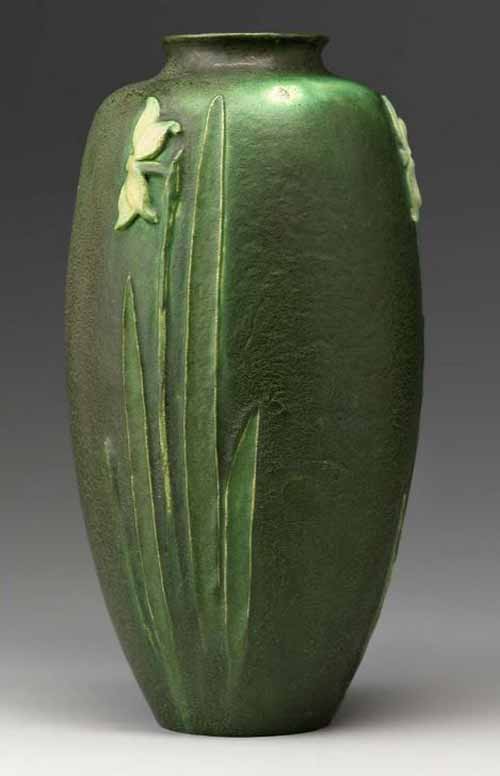
Ceramics produced in the Boston area in the late 19th century established a standard of excellence for American art pottery. Influx of immigrant potters from England transferred technical expertise. Everything had to be perfectly adapted to the use for which it was intended: stylistic sources, craftsmanship, art education, and design reform. Not only was the Paul Revere Company influential, but the Dedham, Grueby, and Marblehead companies all made contributions to the field. Grueby, founded in 1894, developed a line of naturally shaped forms onto which hand sculpted and stylized designs were either carved or placed above the surface of the pot. The simple vases introduced matte glazes, including the matte cucumber green that became the company's hallmark. A vase produced between 1899 and 1909 shows an attenuated narcissus, similar to the floral motifs included in Central Congregational’s stained glass décor.
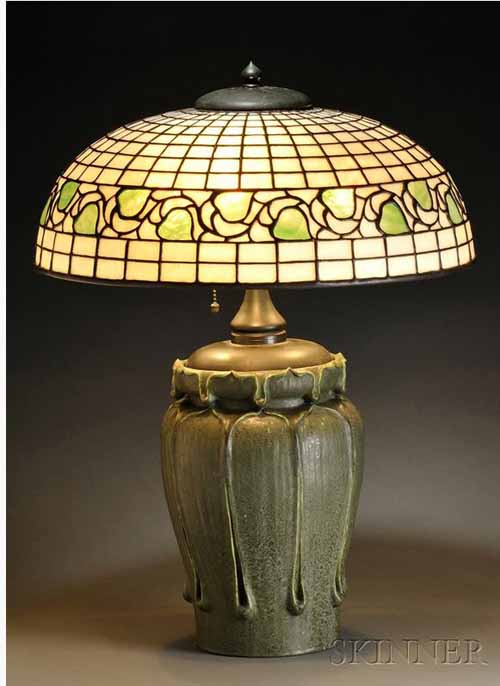 Gustav Stickley (1858–1942), founder of The United Crafts (later known as the Craftsman Workshops), was a spokesperson for the craftsman ideal. Stickley set out to improve American taste through "craftsman" or "mission" furniture with designs governed by honest construction, simple lines, and quality material. In particular, his early furniture, produced between 1901 and 1904 developed the styles of benches, chairs, sideboards, and other practical
Gustav Stickley (1858–1942), founder of The United Crafts (later known as the Craftsman Workshops), was a spokesperson for the craftsman ideal. Stickley set out to improve American taste through "craftsman" or "mission" furniture with designs governed by honest construction, simple lines, and quality material. In particular, his early furniture, produced between 1901 and 1904 developed the styles of benches, chairs, sideboards, and other practical 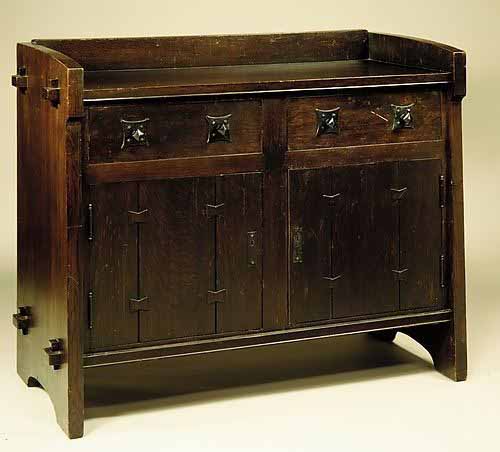 work that were then numbered and promulgated. Stickley incorporated Grueby tiles in his stands and tables and in 1901 shared a stand with Grueby at the Pan-American Exposition, a World's Fair held in Buffalo, New York. The Stickley catalog offered Grueby vases and lamps, such as the Grueby and Bigelow & Kennard Table Lamp (Boston, Massachusetts, c. 1904: Skinner, 20th Century Design - Jun 25, 2011, Lot: 296). Tiffany Studios incorporated Grueby lamp bases as well.
work that were then numbered and promulgated. Stickley incorporated Grueby tiles in his stands and tables and in 1901 shared a stand with Grueby at the Pan-American Exposition, a World's Fair held in Buffalo, New York. The Stickley catalog offered Grueby vases and lamps, such as the Grueby and Bigelow & Kennard Table Lamp (Boston, Massachusetts, c. 1904: Skinner, 20th Century Design - Jun 25, 2011, Lot: 296). Tiffany Studios incorporated Grueby lamp bases as well.
These now well-known developments were actually results of the pioneering activities of individuals such as Sarah Wyman Whitman, one of the founding members of the Boston’s Society of Arts and Crafts. Central Congregational Church in Worcester stands as her first known commission for decorative work, dating from 1883. The Church’s pastor, Daniel Merriman, was the husband of Whitman’s friend and fellow artist Helen Bigelow Merriman. Whitman’s signature Arts and Crafts inspired all aspects of the church’s interior. Although the wall decoration has been altered, her style remains visible in the stained glass windows and fireplaces. These artistic expressions not only impressed visitors but also encouraged them to congregate prayerfully in the beautiful space.
To these deeply spiritual individuals, beauty was a key part of giving back to people. Sarah Wyman Whitman and Helen Merriman, two of the greatest contributors to the church, were from social positions of wealth and privilege. Whitman and Merriman’s generosity rose to the level of funding all of Whitman’s interior work at Central Congregational. Part of their social obligation was to provide aesthetic uplifting experiences through not only creating art, but by teaching, writing, and supporting others.
While Whitman’s designs were pure and honest, they simultaneously expressed a message of wholesomeness and splendor. The allusion to nature and the organic is a recurrent motif in her stained glass windows and fireplace designs. The colors of brick, wood, and glass permeated the interior. Color images of the interior are as yet unlocated. We can assume, however, that they followed other Arts and Crafts harmonies that favored natural tones such as emerald, olive, rose madder, ochre, or sage.
aUpon viewing the chancel of Central Congregational Church, the visitor was embraced by the elegant and simple beams that support the woodwork. The curving vaults were decorated with an intricate flower motif that echoed the organic design and repetition characteristic of the Arts and Crafts aesthetic. Dark wood paneling, found throughout the building, further contributed to the warmth of the space. The walls supported floral borders at the upper levels, and on the lower level golden letters carried inscriptions in the same handwriting that was Whitman’s signature creation. Floral motifs similar to her books border the central panting and many of the door frames. The church’s original choir rails and pews made allusion to the signature Gustav Stickley furniture, representing a simple horizontal with elegantly spaced vertical units. True to the spirit of the Arts and Crafts movement, the spaces of Congregational Church strove to embody the values of sincerity, honesty, and inclusion as principles of worship.
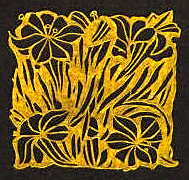
Further Reading
Chalmers, Meg, and Judy Young. The Saturday Evening Girls: Paul Revere Pottery. Atglen, PA : Schiffer Pub., 2005.